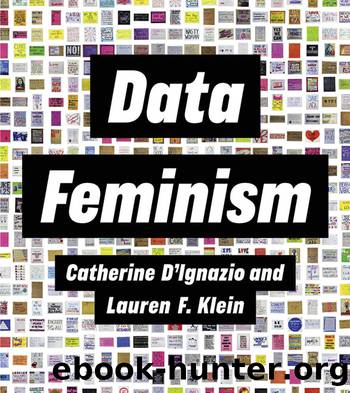Data Feminism by Catherine D'Ignazio & Lauren Klein

Author:Catherine D'Ignazio & Lauren Klein [D'Ignazio, Catherine & Klein, Lauren]
Language: eng
Format: epub
Tags: non-binary; genderqueer; big data; data science; artificial intelligence; emancipation; #MeToo; justice; race; class; sexuality; power; intersectionality
Publisher: MIT Press
Published: 2020-02-21T00:00:00+00:00
Figure 6.6
Two portrayals of the same data analysis. The data are from a study of people incarcerated for the first time in NYC jails between 2011 and 2013. Graphics by Catherine D’Ignazio. Data from Fatos Kaba et al., “Disparities in Mental Health Referral and Diagnosis in the New York City Jail Mental Health Service.”
The study that produced these numbers contains convincing evidence that we should distrust diagnosis numbers due to racial and ethnic discrimination. The first chart does not simply fail to communicate that but also actively undermines that main finding of the research. Moreover, the language used to refer to people in jail as inmates is dehumanizing, particularly in the context of the epidemic of mass incarceration in the United States.51 So, consider the second chart: Racism in Jail: People of Color Less Likely to Get Mental Health Diagnosis. This title offers a frame for how to interpret the numbers along the lines of the study from which they emerged. The research study was about racial disparities, so the title and content of this chart are about racial disparities. The people behind the numbers are people, not inmates. In addition, and crucially, the second chart names the forces of oppression that are at work: racism in prison.
Although naming racism may sound easy and obvious to some readers of this book, it is important to acknowledge that fields like journalism still adhere to conventions that resist such naming on the grounds that it is “bias” or “opinion.” John Daniszewski, an editor at the Associated Press, epitomizes this view: “In general our policy is to try to be neutral and precise and as accurate as we possibly can be for the given situation. We’re very cautious about throwing around accusations of our own that characterize something as being racist. We would try to say what was done, and allow the reader to make their own judgement.”52
Daniszewski’s statement may sound democratic (“power to the reader!”), but it’s important to think about whose interests are served by making racism a matter of individual opinion. For many people, racism exists as a matter of fact, as we have discussed throughout this book. Its existence is supported by the overwhelming empirical evidence that documents instances of structural racism, including wealth gaps, wage gaps, and school segregation, as well as health inequities, as we have also discussed. Naming these structural forces may be the most effective way to communicate broad context. Moreover, as the data journalist in this scenario, it is your responsibility to connect the research question to the results and to the audience’s interpretation of the results. Letting the numbers speak for themselves is emphatically not more ethical or more democratic because it often leads to those numbers being misinterpreted or the results of the study being lost. Placing numbers in context and naming racism or sexism when it is present in those numbers should be a requirement—not only for feminist data communication, but for data communication full stop.
This counsel—to name racism, sexism, or
Download
This site does not store any files on its server. We only index and link to content provided by other sites. Please contact the content providers to delete copyright contents if any and email us, we'll remove relevant links or contents immediately.
The Rules Do Not Apply by Ariel Levy(4908)
On the Front Line with the Women Who Fight Back by Stacey Dooley(4838)
The Lonely City by Olivia Laing(4768)
Bluets by Maggie Nelson(4510)
The Confidence Code by Katty Kay(4219)
Three Women by Lisa Taddeo(3391)
Not a Diet Book by James Smith(3373)
Inferior by Angela Saini(3293)
Confessions of a Video Vixen by Karrine Steffans(3273)
A Woman Makes a Plan by Maye Musk(3222)
Pledged by Alexandra Robbins(3152)
Wild Words from Wild Women by Stephens Autumn(3115)
Nice Girls Don't Get the Corner Office by Lois P. Frankel(3020)
Brave by Rose McGowan(2804)
Women & Power by Mary Beard(2749)
Why I Am Not a Feminist by Jessa Crispin(2721)
The Girl in the Spider's Web: A Lisbeth Salander novel, continuing Stieg Larsson's Millennium Series by Lagercrantz David(2699)
The Clitoral Truth: The Secret World at Your Fingertips by Rebecca Chalker(2691)
A Burst of Light by Audre Lorde(2568)
